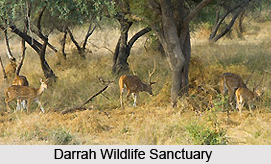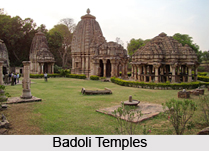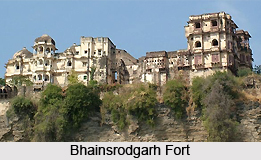 Local transportations are easily available to tour the places lying around Kota. Packaged tours are also offered to the tourists. Touring the places of interest around Kota will be a memorable experience for the travelers.
Local transportations are easily available to tour the places lying around Kota. Packaged tours are also offered to the tourists. Touring the places of interest around Kota will be a memorable experience for the travelers.
Keshoraipatan: This is located 22 kilometers northeast of Kota. It was the residence of presiding deity of Hadoti, Shri Keshav Raiji. The lord is also known as Keshoraipatan. This medieval temple has robust fortification just like any other citadel. The holy shrine is located on the bank of Chambal River. A grand fair takes place in the month of Kartik. During this fair the devotees take dip in the river, seek the Lord Krishna`s blessings and enjoy the boat race. This place is also famous for handicrafts belonging to the Hadoti kingdom. 3 kilometers away from this place lies the beautiful rock paintings adorn the bank of River Alaniya.
Darrah Wildlife Sanctuary: It was once upon a time the hunting reserve for the royal family of Kota. It is located at a distance of 50 kilometers from Kota. The sanctuary is situated on a sprawling 250 km. Wild animals like leopard, sloth bear, chinkara and wolf are to be found here. This place has been the muse for the Kota School of Rajasthani miniature paintings for ages. Hunting scenes from this sanctuary have been depicted in these paintings time and again.
Sorsan Grasslands: This is another natural paradise and is located at Shergarh. This place is located at a distance of 45 kilometers at the southeast of Kota. A variety of migratory birds are its major attraction. The bird lovers will have a fantastic time here as they can check out several species of birds, such as, larks, warblers, flycatchers and rosy pastors. The perfect time to visit this grassland is from October to March. Endangered species like great Indian bustard are also found here. The visitors can also catch a glimpse of bulbul, quails, partridges, mynas, shrikes, weavers and orioles.
The town of Shergarh is also important for a host of havelis, ancient ruins and temples. There is an inscription within the town that establishes its antiquity.
Badoli Temples: This is one of the oldest places in Rajasthan. The temples that are found here are dated between 9th to 12th centuries. Muslim invaders destroyed many of these temples but the ruins still attract. Amongst these temples the temple of Ghateshwara dedicated to Lord Shiva stands out. Here the god is depicted in various forms-- Shiva slaying the demon Chamunda, dancing Shiva and also the one with deities of Brahma and Vishnu and various other deities of the Hindu mythology. The pillars of this temple have been superbly carved with the figures celestial nymphs. There are other 2 temples that are worth checking out too. These are Trimurti Temple and Mahishasura-mardini Temple.

Bhainsrodgarh Fort: This fort is located around 10 kilometers on the road to Chittorgarh. Situated upon a cliff top and protected by the river Chambal on two sides, this invincible fort is occupied by descendants of the feudal family. It is open for visitors but a prior permission had to be obtained from the tourist office in Kota.
Jhalawar: It was established by Zalim Singh in 1838 at a distance of 85 kilometers from Kota. This is a well-planed city that was once an important commercial center in the 19th century. It was also a great cultural centre patronising music, theatre and art and boasted a theatre in the palace called Bhawani Natya Shala. The theatre was built emulating the western style opera houses. Cave paintings and massive forts are also important tourist destinations in Kota.
Jhalarapatan: If the travelers travel 6 kilometers further they will arrive at Jhalarapatan that literally means `city of temple bells`. Once upon a time the town had more that 100 temples but now only a few of them remain. The finest temple and the pride of the Jhalawar region is the 10th century Surya Temple. It houses one of the most idols of the Sun God. The ornately carved dome, torana archways and the columns of the temple are worth taking a close look for its fineness. There are 4 more temples located near this shrine. One of them is the 11th century Jain Temple. This temple is dedicated to Lord Shantinath.
Gagron Fort: This is a rare example of a Jal Durg (the fort protected by water). Its foundation was laid in 8th century but it took 6 centuries to complete it. The three sides of this temple are surrounded by waters of Ahu and Kali Sindh rivers. The fort has been fought over for centuries having gone through 14 major battles, to be finally captured by Emperor Akbar in 1561. It is an important part of the history of Rajasthan. The Rajputana resistance, their valor, courage and chivalry have been etched on the walls of this fort. There is also a mausoleum of a Sufi saint, Mitheshah.
 Chandkheri: The main attraction here is the Adinath Jain Temple. It is an important pilgrimage site for the followers of Digambar Jainism. The temple enshrines a huge stone statue of Adinath, the 1st Tirthankar. This place is located 35 kilometers northeast of Jhalawar. Every year in Chaitra Shukla the birth anniversary of the saint is celebrated with a lot of fervor.
Chandkheri: The main attraction here is the Adinath Jain Temple. It is an important pilgrimage site for the followers of Digambar Jainism. The temple enshrines a huge stone statue of Adinath, the 1st Tirthankar. This place is located 35 kilometers northeast of Jhalawar. Every year in Chaitra Shukla the birth anniversary of the saint is celebrated with a lot of fervor.
Kolvi: Ancient Buddhist caves and stupas are the main local attraction at this ancient town. It is believed that these date back to the 5th century. Located near a rivulet Kyasari, the Buddhist site has two storeyed rooms (vihar), meditation chambers (chaitya) and large stupas with images of Buddha. A 15 feet high icon of a Bodhisatva is the largest statue at Kolvi. It is located 95 kilometers away from Jhalawar. All the hallmarks of a rock cut temple are present in this shrine pillars and high ceilings of the halls.
Dharm Rajeshwar: The tourists will come across a monastery at the foot of this hill. It is located on the border of Rajasthan and Madhya Pradesh. Within the monastery there is a huge figure of Buddha surrounded by his disciples.



















